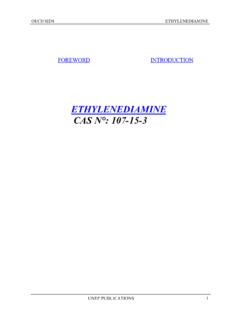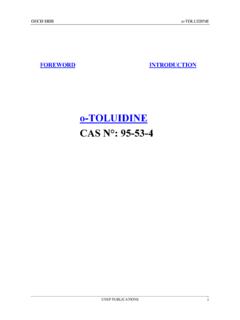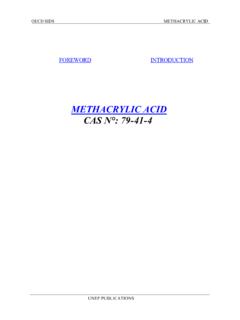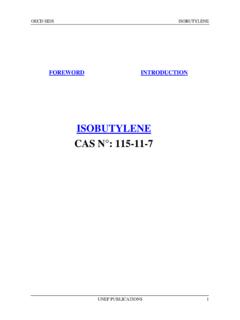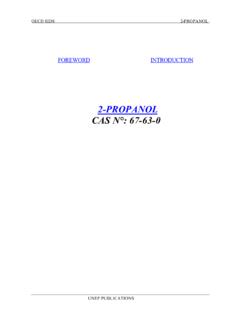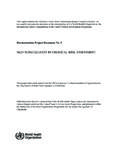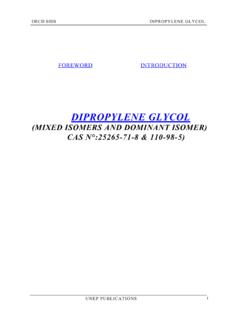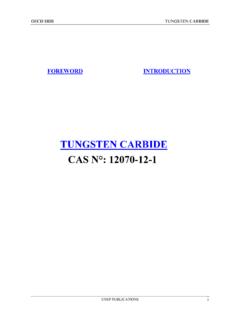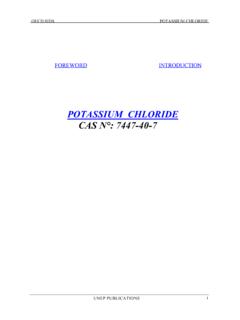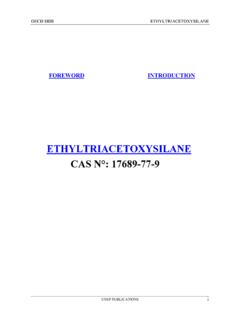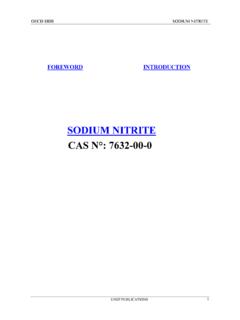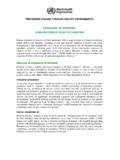Transcription of AMINOTRI(METHYLENEPHOSPHONIC ACID) CAS N°: 6419 …
1 OECD SIDS AMINOTRI(METHYLENE PHOSPHONIC acid . FOREWORD INTRODUCTION. AMINOTRI(METHYLENEPHOSPHONIC acid ). CAS N : 6419-19-8. UNEP PUBLICATIONS. Identifiers, Physical and Chemical properties 301. Substance End Point : IDENTIFIERS, PHYSICAL AND CHEMICAL PROPERTIES. Chemical Name : Phosphonic acid , (nitrilotris(methylene))tris- Common Name : AMINOTRI(METHYLENEPHOSPHONIC acid ). CAS Number : 6419-19-8. RTECS Number : SZ9860000. Synonyms Aminotri(methylphosphonic acid ) Aminotris(methanephosphonic acid ). Aminotris(methylphosphonic acid ) ATMP. Briquest 301-500 Budex 5130. Dequest 2000 Dequest 2001. Dowell L 37 Ferrofos 509. Masquol P 320 Mayoquest 1320. Nitrilotrimethanephosphonic acid Nitrilotrimethylphosphonic acid Nitrilotris(methylphosphonic acid ) NTF. NTMP NTPA. Sequion 20H45 Sequion OA. Tris(phosphonomethyl)amine Turpinal MD2. Properties & Definitions Molecular Formula : C3H12NO9P3. Molecular Weight : Melting Point : -14C. Boiling Point : 105C. State : Liquid Flamable Limit : Not regarded as flammable Density : at 20C.)
2 Vapour Pressure : (10E-7mmHg) at 20C CAL. Octanol/Water Partition : log Pow = Coefficient Water Solubility : 610g/l at 25C (very soluble). Surface Tension : Newton/m Impurities : 5% w/w N-methyl nitrolobis(methylene phosphonic acid ); 5% w/w phosphorus acid ; 4% hydroxymethyl phosphonic acid ; 1% w/w aminomethylene phosphonic acid . 1% w/w orthophosphoric acid General Comments : Product is sold as aqueous solution,containing 50% w/w or less of the active acid at pH<2 ( acid solution) and pH neutral (sodium salt solution). Decomposition takes place at 200-250C. Will give off phosphine, if heated above 200C, which is toxic and flammable gas. Overall Evaluation SIDS INITIAL ASSESSMENT. This chemical is presently of low concern. There is needs for further work. SHORT SUMMARY OF THE REASONS WHICH SUPPORT THE RECOMMENDATION. The maximum tolerable concentration is three to four orders of magnitude higher than the predicted environmental concentrations of ATMP in water.
3 ATMP is readily adsorbed to sediment, however there is little evidence of repartitioning, therefore the bioavailability to sediment-dwelling organisms would appear to be low. In conclusion, ATMP represents little risk to the environment. The substance is not acutely toxic, nor, from the experimental evidence does it have mutagenic, teratogenic or carcinogenic properties. IRPTC Data Profile 302 Identifiers, Physical and Chemical properties Under the predicted conditions of use the chemical is very unlikely to present a risk to health. More information is needed on the mode and frequency of use of the substance and formulations containing it in particular, the potential for aerosol formation should be addressed. IRPTC Data Profile Production-Trade 303. Production-Trade Chemical Name : AMINOTRI(METHYLENEPHOSPHONIC acid ). CAS Number : 6419-19-8. Geographic Area : USA. Production Quantity Year 3820 T - P 1989. 700 T - EXP 1989. References !SIDSP*. OECD/SIDS.
4 Screening Information Data Set (SIDS) of OECD High Production Volume Chemicals Programme, (1993). Production-Trade Chemical Name : AMINOTRI(METHYLENEPHOSPHONIC acid ). CAS Number : 6419-19-8. Geographic Area : EUR. Production Quantity Year 3360 T - P. References !SIDSP*. OECD/SIDS. Screening Information Data Set (SIDS) of OECD High Production Volume Chemicals Programme, (1993). Production-Trade Chemical Name : AMINOTRI(METHYLENEPHOSPHONIC acid ). CAS Number : 6419-19-8. Geographic Area : WORLD. General Comments : ATMP production levels worldwide are in the range of 1000 to10000 tonnes per annum. References !SIDSP*. OECD/SIDS. Screening Information Data Set (SIDS) of OECD High Production Volume Chemicals Programme, (1993). IRPTC Data Profile 304 Processes Processes Chemical Name : AMINOTRI(METHYLENEPHOSPHONIC acid ). CAS Number : 6419-19-8. Process Process comments : The product is manufactured in closed reaction vessels, typically as a 50% solution of the free acid .
5 Its is packed directly from the reaction vessel into polyethylene drums or bulk tankers for shipment to the customer. References Secondary Reference : !SIDSP*. OECD/SIDS. Screening Information Data Set (SIDS) of OECD High Production Volume Chemicals Programme, (1993). IRPTC Data Profile Uses 305. Uses Chemical Name : AMINOTRI(METHYLENEPHOSPHONIC acid ). CAS Number : 6419-19-8. Use Quantity Year Comments The product as manufactured (50% solution) is used exclusively for industrial applications or for formulation. 80 % Used as an anti-scaling agent in industrial water cooling. 10 % Used as an anti-scaling agent in industrial boilers 10 % Used as an anti-scaling or bleach stabilisation agent in formulation into cleaners (industrial and institutional: I. & I). In I & I cleaners the concentration is typically at the range. The product is used typically at the 1-5mg/l range. For the first two uses the product is either used as such or reformulated by specialist water treatment companies for specific application purposes.
6 References Secondary References : !SIDSP*. Screening Information Data Set (SIDS) of OECD High Production Volume Chemicals Programme, (1993). IRPTC Data Profile 306 Pathways into the Environment and Environmental Fate Study End Point : Pathway into the Environment and Environmental Fate. Chemical Name : AMINOTRI(METHYLENEPHOSPHONIC acid ). CAS Number : 6419-19-8. Test Method and Conditions Test method : Calculation of compartment concentrations based on known experimentally description derived factors on a worst case basis taking into account dilution, partition to sediments and sewage treatment. Pathway and Transport Pathway : MANUF SPILL. Pathway description : Disposal to river water from cooling tower and other uses. Disposal via sewage treatment works for closed systems. Quantity Transported Medium to Medium Quantity Time Year to Year to AQ %. Water to SEW %. Sewage sludge to SED 77 %. River sediments General Comments : The potential sources of release and hence exposure arise from manufacture (flushing of systems between production runs) spillage during packaging or bulk transfer, spillage during formulation or in dosing of industrial cooling systems, arising from use in I & I cleaners, or, following use, as a result of discharge of cooling or boiler water.
7 There is not thought to be a significant general consumer use. References Primary Reference : #MONSC*. Monsanto Company Unpublished Report Secondary Reference : !SIDSP*. OECD/SIDS. Screening Information Data Set (SIDS) of OECD High Production Volume Chemicals Programme, (1993). IRPTC Data Profile Loss 307. Study End Point : LOSS. Chemical Name : AMINOTRI(METHYLENEPHOSPHONIC acid ). CAS Number : 6419-19-8. Evaluations Evaluation text : Biological degradation is slow in the presence of excess phosphate;. however, several microorganisms can grow on phosphonates as their sole carbon and phosphorus source. High removal rates have been observed in activated sludge treatment mostly due to adsorption to sludge. Slow to moderate biodegradation rates occur in natural sediment/water and soil systems. The binding of ATMP to sediments is very strong. In microcosm studies very little ATMP could be recovered even with severe extraction methods. Photolysis of ATMP is rapid in the presence of ferric ions.
8 References Secondary Reference : !SIDSP*. Screening Information Data Set (SIDS) of OECD High Production Volume Chemicals Programme, (1993). Study End Point : LOSS. Chemical Name : AMINOTRI(METHYLENEPHOSPHONIC acid ). CAS Number : 6419-19-8. Test Subject Organism Medium Specification AQ SEW. Test Results General Comments : A two month study by Monsanto showed no indication of ATMP. degradation in a laboratory sewage treatment system as monitored by chelant titre and orthophosphonate measurement. However, phosphonate levels up to 160mg/l had no inhibitory effect on COD or MBAS removal in the test units. Biodegradattion of radiolabelled phosphonates, including ATMP, at 5mg/l in SCAS systems resulted in to being converted to CO2 during the 210 day test. The authors attributed the degradation to either minor impurities or slow photolysis followed by biodegradation. IRPTC Data Profile 308 Loss References Primary Reference : #MONSC*. Monsanto Company Unpublished Report Secondary Reference : !
9 SIDSP*. Screening Information Data Set (SIDS) of OECD High Production Volume Chemicals Programme, (1993). Study End Point : LOSS. Chemical Name : AMINOTRI(METHYLENEPHOSPHONIC acid ). CAS Number : 6419-19-8. Test Subject Organism Medium Specification AQ. Species/strain/system : Meramec river water Test Substance Description of the test : Radiolabelled ATMP. substance Test Method and Conditions Test method : River die-away test description Test Results Quantity Time Comments on result 6 % 60 d When biological activity was inhibited. % 60 d In active natural water, (14)CO2 evolution was in the dark and in the light. References Primary Reference : #MONSC*. Monsanto Company Unpublished Report Secondary Reference : !SIDSP*. Screening Information Data Set (SIDS) of OECD High Production Volume Chemicals Programme, (1993). IRPTC Data Profile Loss 309. Study End Point : LOSS. Chemical Name : AMINOTRI(METHYLENEPHOSPHONIC acid ). CAS Number : 6419-19-8. Study type : LAB.
10 Test Subject Organism Medium Specification SLUDG. Species/strain/system : Activated sewage sludge inoculum Test Method and Conditions Test method : OECD Guideline 302A. Inherent biodegradability: modified SCAS test. description pH : 7. (An)aerobic : AEROB. Test Results Quantity Time Comments on result 90 % LOSS 26 d With pH buffered at approx. Without pH buffering only moderate removal. General Comments : The authors used DOC as the measure of removal and could not, therefore, distinguish between adsorption and biodegradation. References Primary Reference : VJWWAU. Horstmann, B. and Grohmann, A. Vom Wasser, 70, 163-178, (1988). Secondary Reference : !SIDSP*. OECD/SIDS. Screening Information Data Set (SIDS) of OECD High Production Volume Chemicals Programme, (1993). IRPTC Data Profile 310 Concentration Study End Point : CONCENTRATION. Chemical Name : AMINOTRI(METHYLENEPHOSPHONIC acid ). CAS Number : 6419-19-8. Test Subject Organism Medium Specification Lifestage Sex AQ.
